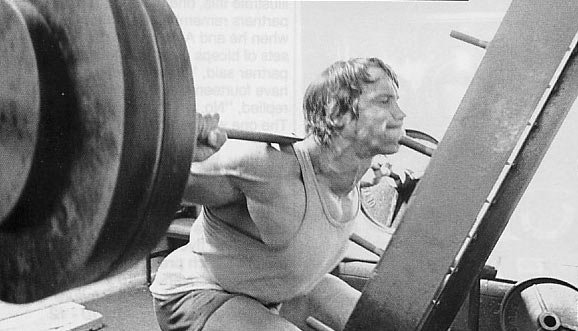Six Things Your Gym Must Have


By Sean Hyson, C.S.C.S.
It’s ironic that the place you go to in order to get in shape may be what’s holding back your progress more than anything else. Gyms have changed a lot since Arnold first broke a sweat in one in 1962. Most aren’t interested in whether you meet your goals or not. As long as they keep traffic moving, and prevent the members from inadvertently killing themselves, they really don’t care if you lose 10 pounds, fill out your shirt sleeves, or show up to bench press wearing a polo shirt and blue jeans.
But I do.
That’s why I’ve come up with some must-haves for choosing a gym that helps you build the body you want—not just one that pays its membership dues.
1) Quality trainers
Even if you’re not interested in personal training, it’s smart to work out in a place that employs people who know what the hell they’re doing. It makes for a better atmosphere, and gives you the opportunity to get sound advice if you ever do want or need it.
A trainer should be certified, preferably through an organization like the NSCA, ACSM, NASM, or ISSA. These are the leading fitness education groups in the industry, and while their philosophies all have their flaws, a cert from them proves at least two things—the trainer took the time to read books and pass a challenging exam, and he/she is serious and passionate about training, not just eager to make a quick buck handing a client his or her own workout.
More important than certification, however, is experience, track record, and mentorship. If a trainer has a long list of testimonials from successful clients, or (if the trainer is young) has interned with somebody who does, you’ve found your guy. Elite trainer and Schwarzenegger.com contributor Jason Ferruggia doesn’t advertise letters after his name, but he’ll train circles around most C.P.T.’s. A short conversation with him is all you need to know that he can help you achieve your goals.
If you’re in the market for a trainer and you want to test their knowledge, ask them how they would “periodize” your training. Periodization is the term for planning training over the long term to ensure continued progress, and the main benefit of paying someone to oversee your workouts. If the trainer gives you a funny look or says “we’ll just keep switching it up”, politely excuse yourself. The same goes if you get some pretentious, blind-them-with-science kind of answer. What you want to hear is that you’ll start with some kind of assessment, and then alternate periods of higher volume and higher intensity. There are all kinds of ways to do that, but that’s the basics of making progress. Not changing the exercises at random every workout and hoping for the best.
2) Good equipment
I won’t train at a gym that doesn’t have a squat rack. If you’re interested in building muscle and strength, I suggest you don’t either. Benches should have soft leather that allows your upper back to really sink in to them for traction. They should be about 12 inches wide if you expect them to support heavy bench pressing. The J-hooks in the racks (those J-shaped things that the bar rests on when not in use) shouldn’t be so deep that you need to roll your shoulders forward to get the bar out. Take note of what Jim Smith wrote about keeping tension in his recent article, “Bench Press 101”.
If you can, train in a place that has a glute-ham raise bench. Regardless of your goals, this apparatus has no equal. It trains the hamstrings two functions (bending your knees and extending your hips) simultaneously, and will increase your squat, your deadlift, and help relieve lower-back pain.
There’s one thing your gym shouldn’t have—dodecagonal plates (those 12-sided ones). I guess they’re only a problem if you’re deadlifting—and you ARE deadlifting, aren’t you?—because the corners bang into the floor between reps and can shake you out of position. Still, old-time round plates are just fine. If the bar rolls so badly that you feel you need angular plates to stop it, allow me to make a suggestion: stop kicking it across the room.
3) The intimidation factor
Going to the gym should never feel like you’re going home. You don’t want it to be that comfortable. It’s tempting to choose a gym because it’s quiet, never gets crowded, and most of the clientele looks like your grandmother. That way, you can coast through your workout, slip out undetected, and tell yourself you trained that day.
Believe me, this is the worst mistake you can make, and no training program, diet, or supplement can make up for it, no matter how effective.
When you enter a gym, you should feel a lot of positive energy and a little bit of anxiety—that’s the mindset you need for focused, intense workouts.
I would never want to be the strongest guy in my gym (and I’m usually in no danger of it). You can only go down from there. If you want to get big and strong, you need to train with people who are bigger and stronger to push you, inspire you, and make you feel that the results you want are both attainable and just a little out of reach. You need a place that makes you anxious for new challenges and afraid of falling behind. Because while I don’t want to be the strongest guy there, I won’t allow myself to be the weakest.
Look for a gym with intense music, a dry-erase board with people’s best lifts on it, a little dust, few mirrors, and camaraderie among the members. Even if your fitness goal is to lose an inch off your waist or just to touch your toes, you won’t get there training at a place that looks and feels like your living room.
4) Like-minded people
I just mentioned camaraderie. Without it, you can do everything right and get good results. With it, you can do everything wrong and get great results. Think of how many guys you see in the gym who don’t know what they’re doing. Their form is awful, they have no clear plan for their workouts, and they probably don’t even eat healthy when they get home. To add insult to injury, they’re in way better shape than you are.
The reason is usually because they bust their asses. And they have the drive to do that because they train with like-minded people who share the same goals, discipline, and ravenous appetite to make gains.
The camaraderie that Arnold had with fellow bodybuilders at Gold’s Gym is legendary, but he might not have made it even that far if he hadn’t found a similar brotherhood growing up in Austria. He makes note of these relationships in his book, The Education of a Bodybuilder.
“Every month, I had at least a week when I didn’t really want to train… These were the days [my friend] Karl pulled me out of it. He’d say, ‘Man, I feel great today! I want to do bench presses. Let’s do 25 instead of 20. How about a contest? Ten shillings to the one who does the most bench presses.’ It worked perfectly…
“It became extremely important to have somebody behind me saying, ‘Let’s do more, Arnold. Come on—another set, one more rep.’ And it was just as important for me to help somebody else… I discovered that the key to successful workouts had to do with competition.”
Even when you aren’t directly competing with other gym goers, just knowing that there is somebody else is in the room who cares about your training as well as his own is an incentive. I said above that a good gym shouldn’t make you feel at home, but it should be populated with your kind of people.
5) Traffic Control
Do your best to go to the gym at a time when you know there will be a handful of other serious people there—not so many that you won’t be able to get to the equipment you want, but not so few that it feels like you’re training alone. There should be enough space that you are aware of noise and activity behind you but it doesn’t interfere with your concentration or safety.
Your gym should always provide you options and a Plan B. If you intend to deadlift but the platform is taken, it should have an open area where you can lay some mats down so that when you drop the bar you won’t dent the floor or wake up the downstairs neighbors. If the cable station is occupied, there should be bands you can rig up as a substitution.
6) A lack of stupid rules
If there’s one place you should be able to go to flout society’s conventions, it’s the gym. Aside from rules that directly affect safety and traffic flow, there shouldn’t be any. These include wiping your sweat off machines after you’ve used them, replacing weights, no cellphones, and no standing in front of the dumbbell rack while lifting.
If your gym doesn’t let you deadlift, get out. If they frown on grunting or the occasional curse word, the hell with them. It’s not imperative that they let you train in socks or Vibrams (toe shoes), but it’s a bonus if they do. I mean, if they let people work out in collared shirts, they ought to allow a fashion statement that actually has an affect on fitness. Training barefoot (or in minimalist footwear, so the sole of your foot is very near the ground without any extraneous support) is highly advantageous for activating certain muscles and getting leverage on lifts. It can even help to reduce knee and lower back pain.
One piece of advice that’s commonly doled out in articles about how to choose a gym is to pick one that’s on your way home from work—the logic being that because you can’t avoid seeing it, you’ll be guilted into going more often.
By all means, disregard this advice. If you need to be shamed into training, you don’t want to be training in the first place. You need to find motivation before you try to find a gym.
I’ve trained at gyms that were terribly inconvenient to get to simply because they were great gyms. I’ve even crossed state lines to train at certain places while I had a gym that was open to me down the block. Apart from the benefits of training in a great place, this accomplished three other things. One, it made every workout something to anticipate—I was much more focused knowing I had to make extra time and plan a route to get to the place. Two, it made me work that much harder once I was there—I wasn’t going to travel a great distance and then half-ass my training. Three, it gave me tremendous satisfaction to know that I was going the extra mile for my training. Literally. I wasn’t using anything as an excuse to let it be less than it could.
At that point, you can’t help but make progress.
ALSO CHECK OUT: Arnold's Epic Giveaway! Win a personalized voicemail message by Arnold!
ABOUT THE AUTHOR

Sean Hyson is the Group Training Director for Men’s Fitness and Muscle&Fitness magazines. He is also the co-author of How To Get Published: Writing Domination in
the Fitness Industry.
Website: http://www.seanhyson.com
Facebook: https://www.facebook.com/pages/SeanHysoncom/207035295999801
Twitter: https://twitter.com/SeanHyson
